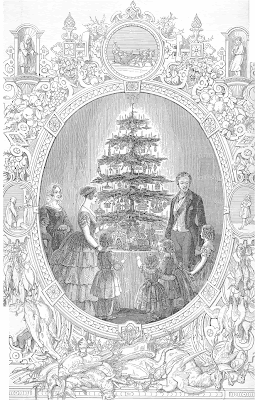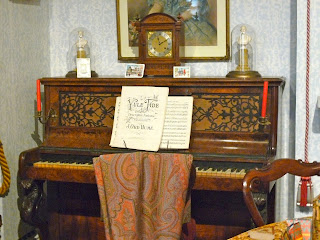Ahh
Christmas, the happy time of the year that makes every “squeezing,
wrenching, grasping, clutching, covetous old sinner” (34) whoop “I
am as light as a feather, I am as happy as an angel, I am as merry as
a school-boy. I am as giddy as a drunken man.” (111), as did
Scrooge in A Christmas Carol...
The snowball fights, the festive lights in every street, shop, home.
The air filled with the smell of spices and roasted chestnuts.
Christmas songs played all around. The seasonal cards garnishing the
mantelpiece. The fir tree waiting to be decorated and the stockings
waiting to be filled with presents. The merriment on every face...
The
excitement and joy of the approaching holiday are in everyone's
hearts and the obsession of Christmas is greatly due to the
Victorians and how they refined these festivities.
During
the 19th Century, Christmas gradually became an important
festival and was soon celebrated by every class of the society (with
extravagance according to one's own means), perhaps because this time
of the year was rather dull, and people took it as an excuse to bring
joy and charm to the bleak winter, have a feast, eat, drink lots and
be surrounded by their loved ones. As we know, Victorians
particularly treasured the time spent with their family, and
Christmas was the perfect occasion to do so; “A
cheerful company assembled round a glowing fire” (Dickens:2003:85)
listening to stories. Paradoxically, Christmas stories were often
ghost stories: Dickens' A Christmas Carol for instance.
Another example is his short story “A Christmas Tree”, which
starts by relating different aspects of the Christmas merrymaking
perceived by the narrator (such as the splendid fir tree, the
presents received, the stories read) and then shifts to some of the
most frightening ghosts stories he knows...
Prior
to the Victorians, Christmas was not that popular, being a mix of a
pagan festival dating from the 4th century and, according
to the Protestants who deprecated it, an unnecessary luxuriant
commemoration of Jesus' birth. Christmas' meaning and festivities
evolved throughout history and during the time and the
industrialisation occurring through the 19th century is
responsible for its commercial twist.
Charles
Dickens' novel A Christmas Carol, published in 1843, helped
revive people's interest for Christmas. He gave it a spirit of
merriment, of a family-centered celebration and a time of compassion,
goodwill and charity. Christmas became more a matter of family
gatherings and generosity than of religious celebration. Dickens'
Christmas stories have been influential in various matters.
 |
| John Leech's illustration of the Ghost of Christmas Present. It contains some elements constituting a 'Dickensian' Christmas: the warm fire, the feast and wassail and the greenery. |
Victorians
were very fond of Christmas, and preparations often started months in
advance with the planning of the party, the making of gifts, the
writing of the greeting cards, and so on. It required time, energy
and above all, money! During the 19th Century, Christmas
became fashionable and therefore, commercial! You had to decorate
your home, send cards to all your acquaintances, buy (or make)
presents, crackers, and a succulent dinner, ... The shops thus set up
'Christmas clubs' offering their less fortunate customers a credit on
their festive expenses.
 |
|
Typical
Victorian grocery, reconstructed in the Museum of London.
|
Twelve Days of Christmas
Christmas Eve (24th of December)
On
Christmas Eve, Victorians gathered around the Yule log burning in the
fireplace and the magnificent Christmas Tree took pride of place on a
table: it was the centre of the attention and the source of delight
for the children.
Christmas
Tree:
The custom has been imported from Germany by Queen
Victoria's husband, Prince Albert, and quickly became a 'must-have'
in all the middle-class homes. In 1848, the Illustrated London
News released a picture of the royal family gathering around a
fir tree ornamented with lights and decorations and soon the
traditions was established.
The
tree would be decorated with lights, papers, fruits, sweets and small
presents (the big ones being underneath).
In his short story “A Christmas Tree”, Dickens writes that “There was everything, and more.” (232) hanging from the tree and these collections of objects reminded the narrator of happy memories from the Christmases of his youth. Dickens really tried to make Christmas into a time of joy... and succeeded!
The rest of the home was decorated with diverse sorts of berried evergreens such as the holly, the ivy and the mistletoe. Poor people living in industrial cities, without access to the country could make fake berries by coating peas with melted red wax (Victorian Farm). Magazines, such as the Cassell's Family Magazine in 1881, would give instructions on how to decorate your home to bring a festive look in it.
In his short story “A Christmas Tree”, Dickens writes that “There was everything, and more.” (232) hanging from the tree and these collections of objects reminded the narrator of happy memories from the Christmases of his youth. Dickens really tried to make Christmas into a time of joy... and succeeded!
The rest of the home was decorated with diverse sorts of berried evergreens such as the holly, the ivy and the mistletoe. Poor people living in industrial cities, without access to the country could make fake berries by coating peas with melted red wax (Victorian Farm). Magazines, such as the Cassell's Family Magazine in 1881, would give instructions on how to decorate your home to bring a festive look in it.
Alongside
the greenery and the tree, you could also admire the Christmas cards
standing on the mantelpiece or the cabinet.
This
is what a typical middle-class Victorian living room would look like
at Christmas: the Christmas tree standing in all its splendour, the
toys on the table, the cards displayed on the cabinet and a sheet
music of a Christmas carol waiting to be played. The photos were
taken at the exhibition “Christmas Past, Christmas Present” at
the Geffrye Museum.
Christmas
Cards:
The
Christmas card is an English invention. The first was made at the
request of Henry Cole in 1843 and was designed by John Calcott
Horsley. Henry Cole wanted to send his kinfolk something more
original that the traditional Christmas letter.
First
Christmas card (1843): It represents well the spirit of Christmas
according to the Victorians; people gathered around a feast and on
the sides, representation of charity. It also included what would
soon become the traditional message: “Merry Christmas and Happy New
Year”.
His
idea proved to be very popular and soon everyone who could afford it
was sending Christmas cards. But as it was quite pricey, people and
especially children (included Queen Victoria's) made their own.
According to the BBC “History of Christmas”, the Christmas card
industry was well on its way by the 1880s, producing not less than
11.5 millions cards in one year. The progress in printing allowed the
designs to be more elaborated and also allowed the production to be
less expensive. The sending of Christmas cards was soon within the
reach of (almost) all budgets.
 |
|
You
could buy them at the stationery.
This is the reconstructed
stationery at the Museum of London.
|
The
night was spent with the exchange of gifts and joyous party games,
pantomimes, musical performances and finally everyone went to bed
with a merry heart.
Christmas
Gifts:
The
gifts were originally simple and handmade, being an exotic fruit such
as an orange, or a needlework or anything useful, but along with the
commercialisation of Christmas – and only among the middle class –
the gifts became elaborate and children received beautiful toys such
as the ones presented in Emma Constantine's entry. It is explained in the
Victorian Farm Christmas episode that poor people gave each other
what they could find or make by themselves.
Christmas Day (25th of December)
On
Christmas Day, families attended the Christmas Mass, and in a spirit
of Christian charity, they would give money or food to the poor in
the streets.
They
then proceeded to have their Christmas dinner. This gargantuan feast
consisted of turkey, flaming brandy plum pudding, mince pies and
other pastries, meringues, apple tarts, …
Now,
interestingly, the replacing of the goose as a main dish by a turkey
was influenced by A Christmas Carol: intentionally the
Cratchits were having a goose, but Scrooge, in his sudden burst of
generosity, bought them a turkey “twice the size of Tiny Tim”
(113). Dickens implying there that a turkey was a bigger and more
magnificent bird than a goose. During the 19th century,
rich people would then have a roast turkey instead of other meats.
The Christmas pudding was also popularised by Dickens, as the
Cratchits go on and on, claiming that their pudding was the most
extraordinary thing, the “greatest success achieved by Mrs.
Cratchit” (81). The passage also proves that no matter your means,
a lovely family time at Christmas was always enjoyable, it was as
much a matter of hospitality than of abundance!
Another
aspect of the commercial Christmas was the invention of the Christmas
crackers in 1847 by the British confectioner Tom Smith. He had been
influenced by the French 'bonbons' (“sugared almonds wrapped in
twists of paper”) during a trip to Paris in 1840 and got the idea
of filling sweets in a package that would break when pulled apart.
Smith, being ambitious, was always trying to improve his invention
and stimulate its sale, when a truly innovative idea came to his mind
while he was sitting before a fire: the crackle of a log inspired him
to make his cracker 'crack' and the commercialisation of it was due
to its uniqueness and in Smith's talent in business. People usually
pulled their crackers during or after the meal.
Throughout
the day, carolers would go singing door to door in the hope of
receiving a warm drink.
Boxing Day (26th of December)
Boxing Day was a day devoted to charity, and as seen in Helene's entry, people went to see Pantomimes.Epiphany (6th of January)
The Twelfth Night
(5th of January) marked the end of the Twelve Days of
Christmas. According to what I have read at the Geffrye Museum, the
tradition was to have a family party with the random election of a
King and Queen for the night. They had a Twelfth-Night cake,
containing a dried bean and a pea. The man finding the bean would be
proclaimed King and the woman finding the pea was the Queen, the rest
of the party were their 'courtiers'. However, the Victorians did not
keep this tradition and the cake became increasingly decorative, but
did not contained a bean nor a pea anymore. The night was then
dedicated to games of charades.
Dickens defines the
Christmas spirit in “What Christmas is, as we grow older” as
being “the spirit of active usefulness, perseverance, cheerful
discharge of duty, kindness, and forbearance!” (249) and instil it
to his Victorian audience through his writings, and particularly
through the more than famous A Christmas Carol, where
the unkind and malevolent Scrooge goes from claiming that “every
idiot who goes about with 'Merry Christmas,' on his lips, should be
boiled with his own pudding, and buried with a stake of holly through
his hearth.” (36) to wishing “A merry Christmas to everybody! A
happy New Year to all the world!” (111) while spreading his joy all
around him.
And if
my entry inspired you to make your own Victorian Christmas, here is a
link where you can find all the tips and tutorials from the show
“Victorian Farm” (BBC). Have fun!
A
Merry Christmas and a Happy New Year
Works cited
Dickens,
C. A Christmas Carol and Other Writings.
London: Penguin Classics, 2003.
Miles,
C.A., Christmas customs and traditions, their
history and significance. New York: Dover
Publications, 1976.








No comments:
Post a Comment